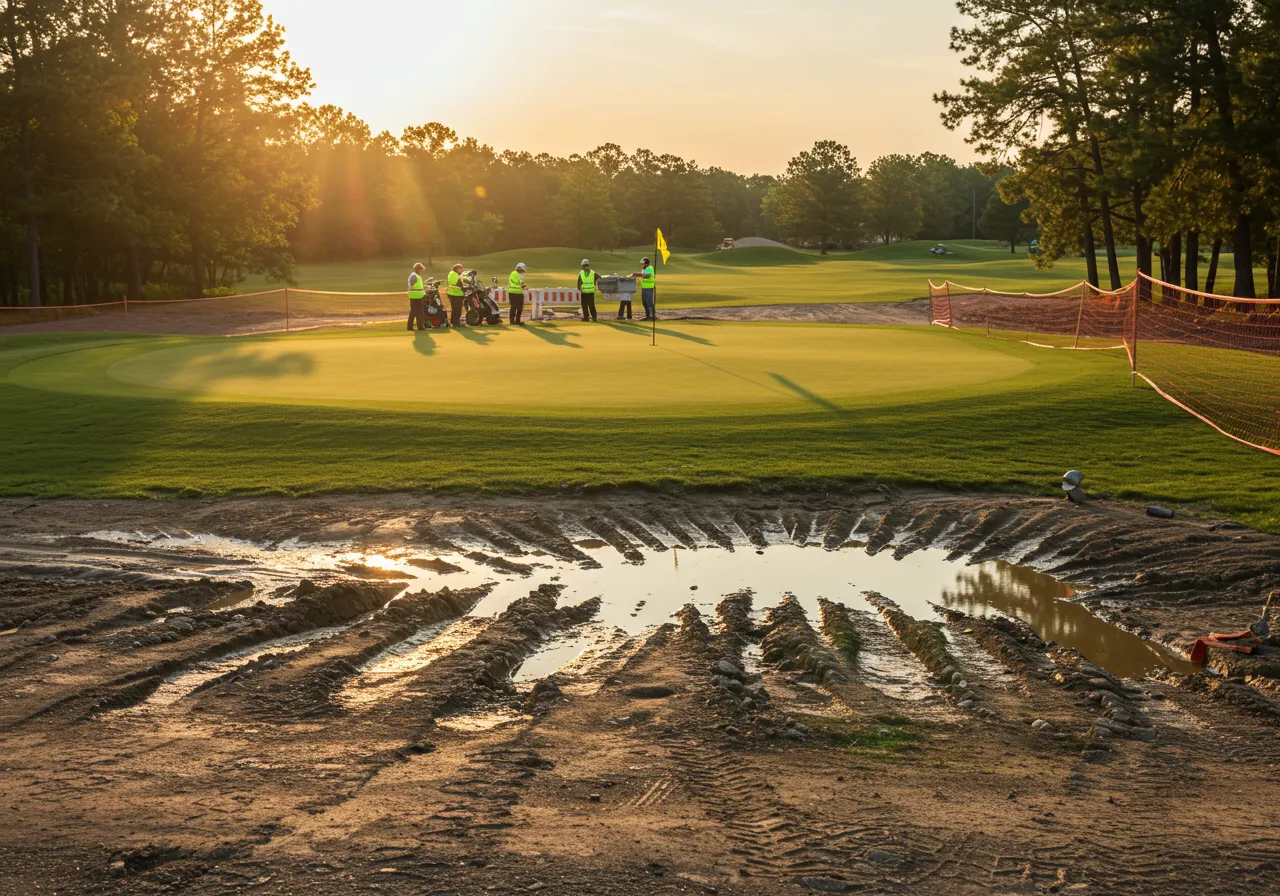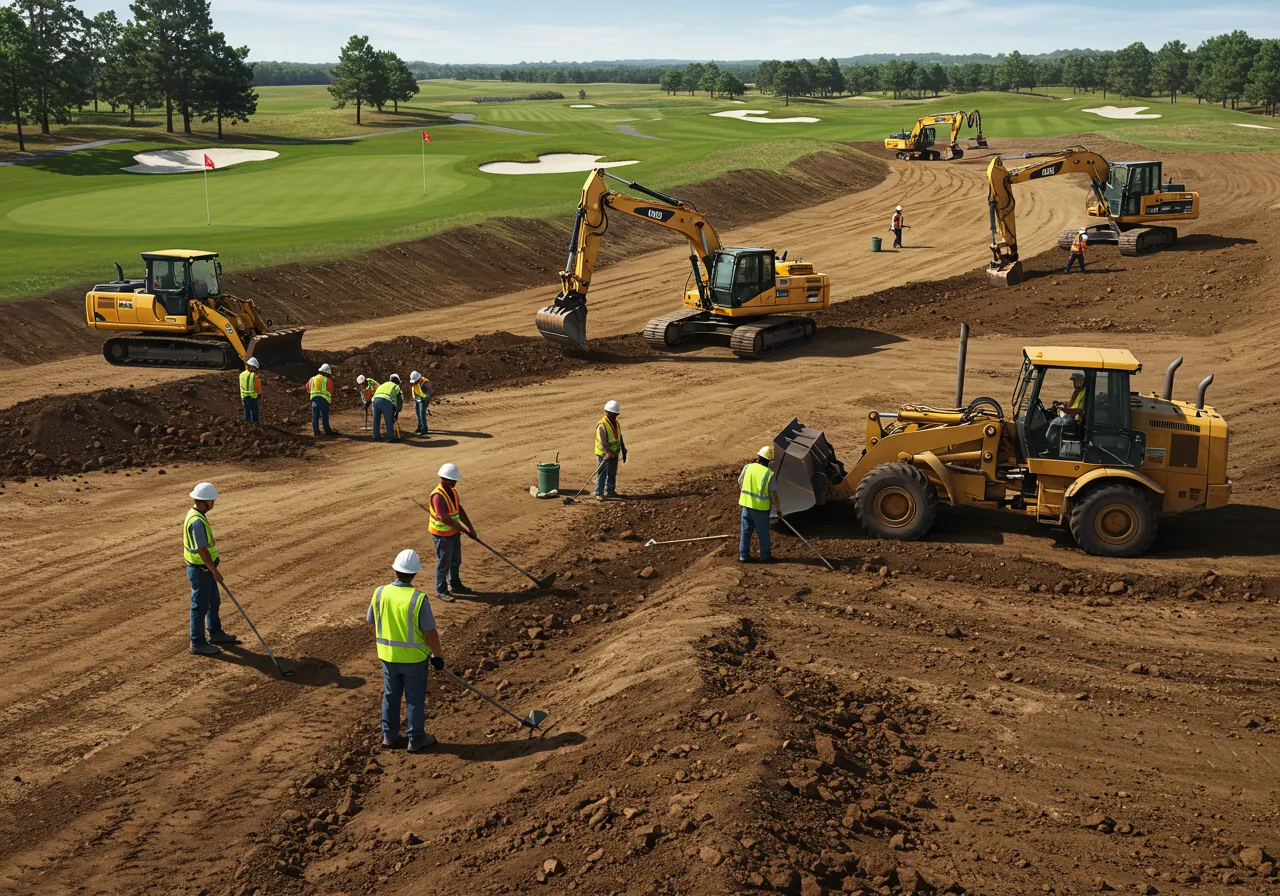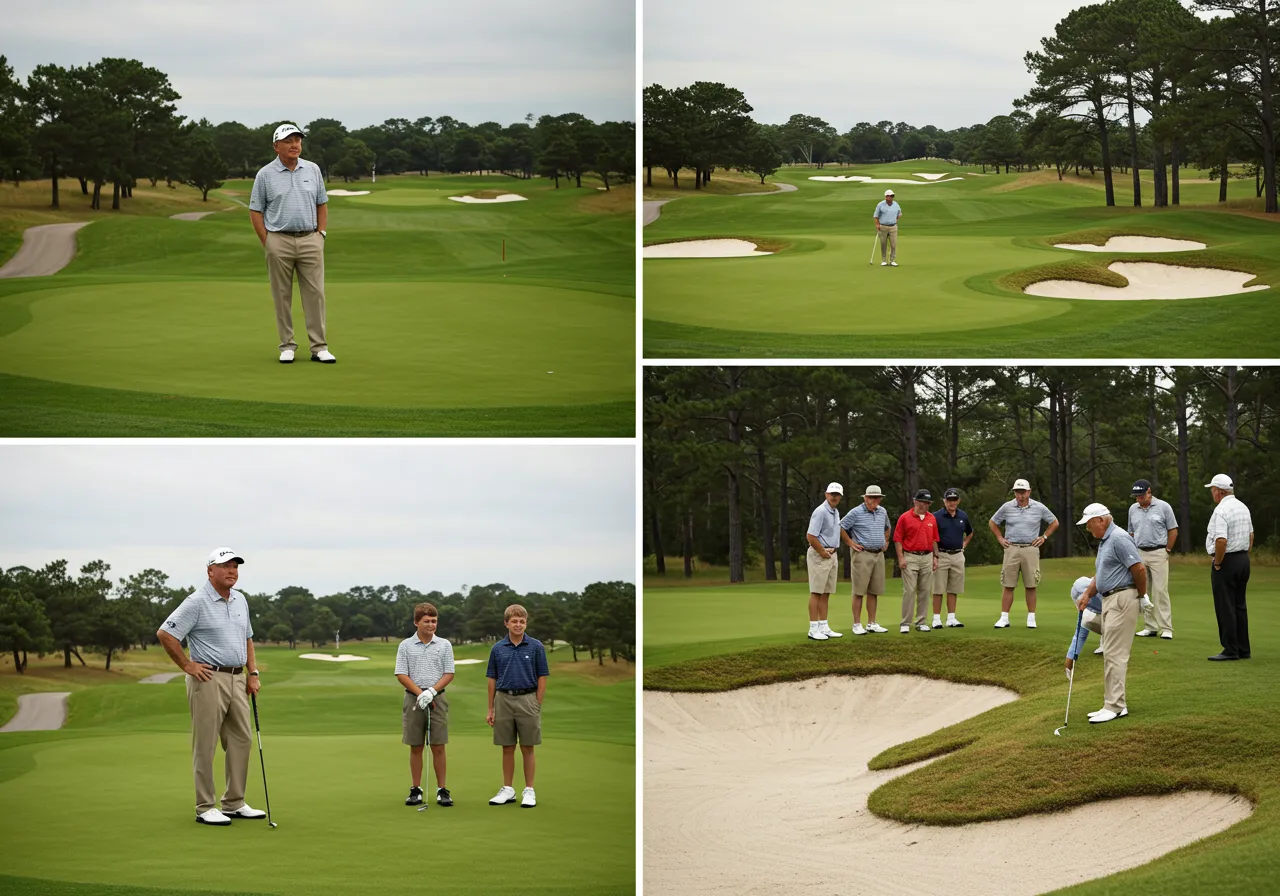How Long Does It Take To Build A Golf Course
How Long Does It Take To Build a Golf Course? Building a golf course usually takes between 18 months and 4 years. This includes everything from buying the land to opening the course for players.
The total time depends on how tricky the land is, how detailed the golf course design is, and how fast permits are approved.
Here’s how the time breaks down:
- Planning and getting permits: 6 to 12 months
- Clearing land and shaping the ground: 3 to 6 months
- Adding water systems and drainage: 2 to 4 months
- Making the greens and fairways: 2 to 3 months
- Letting the grass grow (called grow-in time): 6 to 12 months
Things like bad weather, slow permits, or hard-to-build land can slow it down. Big golf courses like PGA-level ones need more time because they are larger and more detailed.
So, depending on the course size and location, building a golf course takes at least 2 years, and sometimes more.
Step-by-Step Golf Course Construction Timeline from Planning to First Tee Shot

As someone who has spent years around golf courses, playing, consulting, and walking builds from dirt to fairway, I can tell you that building a course is a big job. It doesn’t happen overnight.
Every course follows a set path, and the time it takes depends on the land, weather, and how smoothly each phase goes. Below is the full golf course construction timeline in simple terms.
Phase | What Happens | How Long Does It Take |
Phase 1: Feasibility & Planning | This stage starts with picking the land, checking the market, and making sure the site is allowed for golf. You also begin early environmental checks and make a budget plan. | 6–12 months |
Phase 2: Design & Permitting | A golf course architect draws the full design. At the same time, you apply for important permits like water rights and environmental approvals. | 6–12 months |
Phase 3: Construction & Shaping | The ground gets cleared, shaped, and leveled. Irrigation and drainage systems are installed. Greens and bunkers are formed. This is where the course starts to take shape. | 12–24 months |
Phase 4: Grow-In & Turf Maturation | This is the waiting game. Grass is planted and allowed to grow until it’s ready for play. You water, mow, and care for it every day. | 6–12 months |
Phase 5: Pre-Opening & Final Touches | Last fixes are made to the course, the clubhouse gets finished, and you do a soft opening before letting the public play. |
Note: This table shows the typical timeline for building a golf course, from the very first steps to opening day.
How Long Does It Take for a New Golf Course to Be Playable After Groundbreaking

From my experience helping with course builds and playing on newly finished layouts, I’ve seen that turning a bare piece of land into a smooth, playable golf course is a slow and steady process.
It’s not just about putting grass down, it’s about shaping the land, setting up strong drainage and irrigation, and giving the grass enough time to grow in right.
How Many Months Until a 9-Hole or 18-Hole Golf Course Can Open for Play
Most standard 9-hole or 18-hole courses are ready to play in 12 to 24 months after construction begins. That includes all the hard work, like:
- Grading the land so it drains properly
- Installing sprinklers and water systems
- Building greens, fairways, bunkers, and tee boxes
- Seeding the entire course and letting the grass grow (called the “grow-in period”)
The grow-in period is really important. If you rush it, the turf won’t hold up well once players start walking and swinging on it.
I’ve seen courses open too soon and regret it later. Good grass needs 6 to 12 months to get strong and healthy.
Why Do PGA-Level and Resort Golf Courses Take 2 to 5 Years to Finish
When building a PGA Tour–level or luxury resort golf course, things take longer, sometimes 3 to 5 years total. That’s because these projects are much more detailed and include:
- More advanced turf types that take longer to grow
- Bigger areas for fans, tournaments, and media teams
- Extra permits and strict environmental rules
- Perfect shaping and grading for tour-level playing conditions
- Custom design work from world-class Golf Course Architects
Every detail has to be just right. I’ve walked these sites during the build, even the slope of a green or the way a fairway drains water matters at that level.
What Can Delay the Opening of a New Golf Course

Even if everything is planned well, some delays can still happen. Based on what I’ve seen, these are the most common causes:
- Permits and Environmental Studies
- If your site is near wetlands or protected land, it takes more time to get legal approvals.
- Water use rights and zoning laws can delay the project before it even starts.
- Weather and Climate
- Heavy rain or extreme cold can stop machines from working.
- High heat can damage young turf during the grow-in phase.
- Shortage of Materials
- Some special items like bunker sand or premium grass seed may take longer to ship or go out of stock, which slows things down.
When Can You Expect to Hit the First Tee
Here’s what to expect:
Course Type | Time Until Playable |
9-Hole or 18-Hole Course | 12–24 months |
PGA Tour-Level Course | 2–5 years |
Mini Golf Course | 3–6 months (usually indoors) |
Golf courses take time, and the best ones never rush it. If you let the process happen step by step, especially the grow-in stage, you’ll get a course that lasts for decades and plays beautifully from day one.
How Much Does It Cost and How Much Land Do You Need to Build a Golf Course

After years of playing and consulting on course development, one of the most common questions I hear from new owners or developers is:
“How much money and land do I need to build a golf course?”
The answer depends on the size of the course and the location, but I’ll break it down simply.
What Is the Average Cost to Build a 9-Hole or 18-Hole Golf Course
If you’re planning to build a 9-hole golf course, expect to spend between $1 million and $5 million.
This covers land shaping, irrigation, grass, and basic buildings. It’s a great option for community play or beginner golfers.
For a full 18-hole golf course, the cost is higher, usually $3 million to $15 million or more, especially if you hire a well-known Golf Course Architect or choose land that needs extra work like drainage or soil improvement.
But remember, this is just the construction cost. Running a golf course day-to-day is another big cost. Things like mowing, watering, staff, clubhouse maintenance, and fertilizer are part of the ongoing operations budget.
How Many Acres of Land Are Needed to Build a Golf Course
From what I’ve seen, land size is just as important as the budget. Here’s a quick guide:
Type of Course | Land Needed |
9-Hole Course | About 50 to 80 acres |
18-Hole Course | Around 120 to 200 acres |
That’s not just for the holes, it includes space for:
- Clubhouse and parking
- Cart paths
- Driving range or practice greens
- Natural areas, ponds, or trees
Also, make sure the land is zoned for golf. You’ll need to check with your local zoning board and sometimes even get approval from the state or environmental authorities, especially if your land touches water, forest, or farmland.
Tip from a Pro
A well-designed golf course doesn’t have to be massive or overly expensive, but it does require smart planning. I’ve seen 9-hole courses become local favorites because they were built with the right land and care.
And I’ve seen million-dollar projects fail because they skipped steps or rushed the process.
If you’ve got the land, the budget, and the time, building a golf course can be one of the most rewarding projects in the world of sports.
Golf Course Construction Cost and Land Requirement Table
Course Type | Estimated Cost | Land Needed (in Acres) | Notes |
9-Hole Course | $1 million – $5 million | 50 – 80 acres | Good for small towns, beginner play, or limited land areas |
18-Hole Course | $3 million – $15+ million | 120 – 200 acres | Standard full course, may include practice greens and driving range |
PGA-Level Course | $15 million – $30+ million | 180 – 250+ acres | Requires top design, large-scale grading, and space for spectators |
Mini Golf Course | $100,000 – $500,000 | Less than 1 acre | For entertainment use, often indoors or in urban areas |
Note: These numbers only reflect initial construction costs.
Is Owning a Golf Course a Profitable Business? A Pro’s View on Golf Course Revenue and Return on Investment

After years in the golf world, I’ve seen courses that thrive and others that struggle. The big question many people ask is:
“Can you really make money owning a golf course?”
Let’s look at what I’ve learned from experience.
How Much Money Can a Golf Course Make in a Year
A golf course earns money in different ways. Here are the main sources:
- Green Fees – This is the money players pay to play a round of golf. For example, a course charging $50 per player and getting 100 players per day could make $5,000 a day just from rounds.
- Memberships – Some courses sell annual or monthly passes. This brings in steady income, especially in private or semi-private clubs.
- Food and Beverage (F&B) – Clubhouses with restaurants or snack bars can earn well, especially during tournaments or weekends.
- Tournaments and Events – Courses that host events like weddings, charity tournaments, or business outings make extra revenue.
A busy public course can make $500,000 to $2 million+ per year, depending on location, number of holes, and pricing. Bigger resorts or private courses may bring in more.
Do Golf Courses Actually Make a Profit? A Real Look at Costs and ROI
Here’s the other side of the story: running a golf course isn’t cheap. The biggest costs include:
- Maintenance – Grass needs mowing, watering, fertilizing, and more. You need a full team and a lot of equipment.
- Staff salaries – Grounds crew, clubhouse staff, golf pros, and managers.
- Utilities – Water and electricity bills, especially during dry or hot seasons.
- Insurance, taxes, and licenses – These add up quickly for big properties.
Because of these costs, some golf courses break even, some lose money, and others make a solid profit. The difference usually comes down to:
- How well the course is managed
- If the land was purchased or already owned
- If the course is busy year-round or only seasonal
I’ve seen well-managed courses turn a strong profit because the owners invested in good turf, great customer service, and smart marketing.
But I’ve also seen beautiful courses fail because they didn’t plan for the high cost of upkeep.
Is Golf Course Ownership Worth It

If you’re passionate about golf and treat your course like a business, it can be profitable. But it takes work.
The key is professional management, consistent traffic, and keeping both the course and customers in top shape.
Who Are the Key People Involved in Building a Golf Course
Understanding the Roles That Make a Golf Course Come to Life
From playing new courses to working alongside course owners and builders, I’ve seen firsthand that creating a golf course takes more than machines and money — it takes the right people. Each person has a role that shapes the course before the first golfer even swings a club.
What Does a Golf Course Architect Do in the Design Process
Every great golf course starts with a vision, and that vision comes from a Golf Course Architect.
They are trained experts who design the layout of each hole, decide where bunkers go, how the greens break, and even how the course flows from start to finish.
They mix strategy, beauty, and playability, and they have to work with the natural shape of the land. I’ve played on courses designed by top architects, and you can feel the difference in every shot.
Who Are the Famous Golfers Who Design Courses

Some golf pros also become course designers after their playing careers. Tiger Woods, Jack Nicklaus, and Greg Norman are just a few big names who have designed amazing courses all over the world.
They often work with architects to bring their on-course experience into real-life course designs.
I once played a course designed by Jack Nicklaus, and trust me, it plays as smart as he did in his prime.
What Is a Grow-In Superintendent and Why Is Turf Care So Important
Once the course is built, you still can’t play right away. That’s when the Grow-In Period Superintendent takes over.
Their job is to make sure the grass (turf) grows strong, smooth, and healthy.
They water, mow, fertilize, and care for the turf every day during the grow-in period, which usually takes 6 to 12 months.
This is one of the most important roles in golf course construction, because if the turf isn’t right, the course won’t be either.
What Is the Role of Permits in Golf Course Construction Projects
Before you can break ground, you need construction permits. These come from local governments and cover:
- Land zoning
- Water use rights
- Environmental approvals (especially near wetlands or forests)
I’ve seen courses delayed by months just waiting for permits. That’s why smart developers start this part early. It’s not the fun part, but it’s a crucial step in the development journey.
Every Golf Course Is Built by a Team of Experts

It’s not just grass and golf carts, it’s about smart planning, expert design, and skilled turf care.
When all the right people come together, from architects to superintendents, the final course doesn’t just look good. It feels good to play, round after round.
Who Builds a Golf Course: Key Roles and What They Do
Role | What They Do | Why It Matters |
Golf Course Architect | Designs the full layout of the course, fairways, greens, bunkers, and flow | They turn open land into a smart, playable golf course |
Famous Player-Designers | Pro golfers like Tiger Woods or Jack Nicklaus, who help design courses with their playing experience | Adds personality and strategy from real golf legends |
Grow-In Superintendent | Cares for the grass during the grow-in period: watering, mowing, and fertilizing | Ensures turf grows strong and smooth before players step on it |
Permit and Zoning Officials | Approve land use, water rights, and environmental rules | No course can start without legal permits, delays often happen here |
Course Construction Crew | Builds the actual course: shaping land, installing irrigation, and building paths | They bring the design to life with machines and skilled labor |
Note: Every golf course is a team project. Even the best design won’t succeed without good turf care and the right legal approvals in place.
FAQs
How long does it take to develop a golf course?
A golf course takes 2 to 4 years to develop, including planning, land zoning, permits, construction, and turf grow-in.
How many acres do you need for a golf course?
A standard 18-hole golf course needs 120 to 200 acres. A 9-hole course needs 50 to 80 acres, depending on layout and land shape.
What’s the average cost to build a golf course?
A 9-hole course costs $1M–$5M, and an 18-hole course can cost $3M–$15M+, based on design, terrain, and irrigation systems.
How much money can you make from owning a golf course?
A profitable golf course can earn $500,000 to $2M+ per year through green fees, memberships, tournaments, and food & beverage sales.
Do golf courses make a profit?
Yes, many golf courses are profitable, but success depends on strong course management, location, and controlling maintenance costs.
Conclusion: How Long Does It Really Take to Build a Golf Course from Start to Finish
After years of playing, visiting, and consulting on golf courses, I’ve learned one simple truth: building a golf course is a long and careful journey, not something you can rush.
From the first land survey to the final mow before opening day, the entire process can take 2 to 4 years (and even longer for PGA-level courses).
The most important lesson I’ve learned? Understanding the timeline is everything. If you know how long each phase takes and you plan for it, your course is more likely to open on time, stay healthy, and turn a profit down the line.
In short, building a golf course is one of the most rewarding challenges in golf. And now that you know what it really takes, you’re already a few strokes ahead.
Posts References:
Golf course design common questions answered
How Long Does It Take To Build A Golf Course